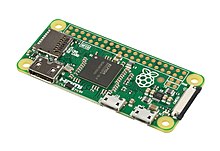Raspberry Pi
The Raspberry Pi is a series of single-board computers. They are low-cost, high-performance and the size of a credit card. The Raspberry Pi was developed in the UK by the Raspberry Pi Foundation. The Raspberry Pi Foundation's goal is to "advance the education of adults and children, particularly in the field of computers, computer science and related subjects."[1] Many people have used Raspberry Pis to make things like cameras, video game consoles, robots, web servers and media centres.


Versions
changeThere are lots of different versions of the Raspberry Pi, and each has different features.
All of the versions use a Broadcom 'system on a chip' (SoC) which contains an ARM-compatible central processing unit (CPU), random-access memory (RAM) and a graphics processing unit (GPU).
All versions use an SD card or MicroSD card for the operating system and file storage. They also have a 40-pin General-Purpose Input/Output (GPIO) connector, which can be used for controlling other electronics.
Some versions of the Raspberry Pi have an ethernet connector for connecting to the internet. Some versions can also use Wi-Fi to connect to the internet.
The Raspberry Pi comes in three different sizes. The 'standard' size is used for all Model B versions, and is 85.6 mm x 56.5 mm (3.370 in × 2.224 in). The 'compact' size is used for all Model A versions, and is 65 mm × 56.5 mm (2.56 in × 2.22 in). The 'zero' size is used for all Raspberry Pi Zero versions, and is 65 mm × 30 mm (2.56 in × 1.18 in).[2]
| Version | Model | Size | Processor | Memory | USB ports | Ethernet | WiFi and Bluetooth | Year Released | Price (USD) |
|---|---|---|---|---|---|---|---|---|---|
| Raspberry Pi | B | Standard | 700 MHz 1-core | 512 MB | 2 | Yes | No | 2012 | N/A |
| A | 1 | No | 2013 | N/A | |||||
| B+ | 4 | Yes | 2014 | $25 | |||||
| A+ | Compact | 1 | No | $20 | |||||
| Raspberry Pi 2 | B | Standard | 900 MHz 4-core | 1 GB | 4 | Yes | No | 2015 | $35 |
| Raspberry Pi Zero | Zero | Zero | 1000 MHz 1-core | 512 MB | 1 | No | No | 2015 | $5 |
| Zero W | Yes | 2017 | $10 | ||||||
| Raspberry Pi 3 | B | Standard | 1200 MHz 4-core | 1 GB | 4 | Yes | Yes | 2016 | $35 |
| A+ | Compact | 1400 MHz 4-core | 512 MB | 1 | No | 2018 | $25 | ||
| B+ | Standard | 1 GB | 4 | Yes | 2018 | $35 | |||
| Raspberry Pi 4 | B (1 GB) | Standard | 1500 MHz 4-core | 1 GB | 2xUSB2, 2xUSB3 | Yes | Yes | 2019 | N/A |
| B (2 GB) | 2 GB | $35 | |||||||
| B (4 GB) | 4 GB | $55 | |||||||
| B (8 GB) | 8 GB | 2020 | $75 |
Features
change- The Raspberry Pi uses the ARM processor architecture, which is also used by many modern mobile phones[source?].
- An operating system can be installed using the Raspberry Pi Imager, or by copying operating system 'images' to an SD card.[4]
- Add-on boards called 'HATs' (Hardware Attached on Top)[5] can be used to give a Raspberry Pi more features, such as LED lights, extra sensors and Power over Ethernet (PoE).[6]
References
change- ↑ The Raspberry Pi Foundation, "About Us". Retrieved 21 July 2015
- ↑ "Mechanical Drawings - Raspberry Pi Documentation". raspberrypi.org. Retrieved 2020-06-11.
- ↑ "FAQs - Raspberry Pi Documentation". raspberrypi.org. Retrieved 2020-06-11.
- ↑ "Raspberry Pi Downloads - Software for the Raspberry Pi". Raspberry Pi. Retrieved 2020-06-11.
- ↑ raspberrypi/hats, Raspberry Pi, 2020-06-10, retrieved 2020-06-11
- ↑ "Introducing the PoE HAT - available now!". Raspberry Pi. 2018-08-24. Retrieved 2020-06-11.
Other websites
change- http://www.raspberrypi.org - The Raspberry Pi Foundation
- https://www.raspberrypi.org/documentation/faqs/ - Frequently Asked Questions about the Raspberry Pi